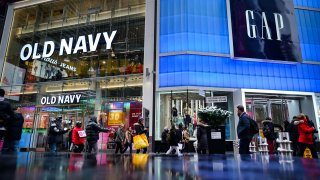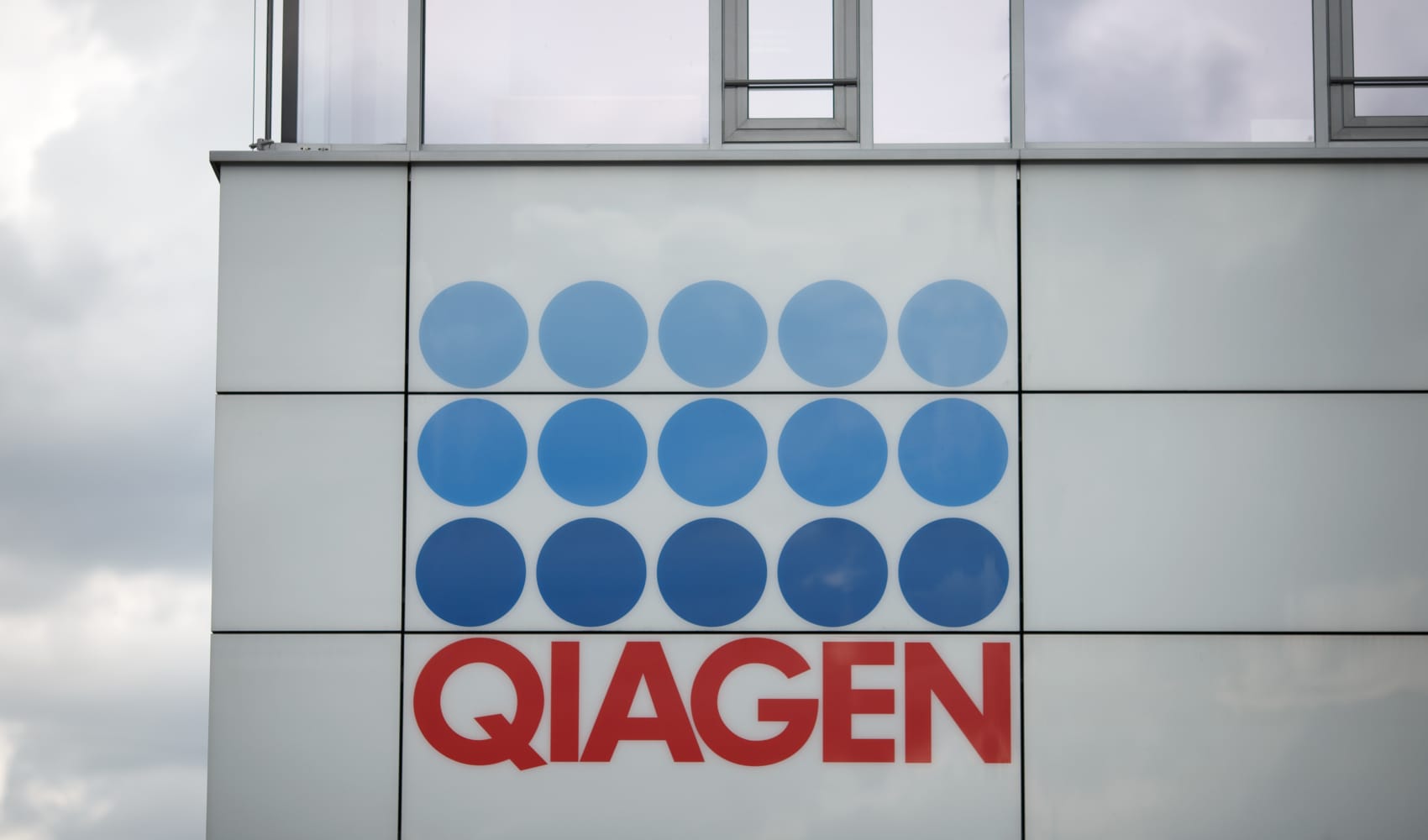
Pedestrians walk past Old Navy and GAP stores in Times Square, New York City.
- Gap reported mixed results on Thursday and underwhelming current-quarter guidance as the longtime mall retailer saw another quarter of declining sales across all four of its brands.
- Sales dropped 8% to to $3.55 billion, compared with $3.86 billion a year earlier.
- Gap has a new CEO at the helm: former Mattel executive Richard Dickson, who started in the new role on Tuesday.
Gap reported mixed results on Thursday and underwhelming current-quarter guidance as the longtime mall retailer warned of an "uncertain consumer" and posted another quarter of declining sales across all four of its brands.
Stream San Diego News for free, 24/7, wherever you are with NBC 7.
The company is projecting net sales to decrease in the low double-digit range for the fiscal third quarter compared to last year's net sales of $4.04 billion. Analysts had expected third-quarter sales to be down 6.8%, according to estimates compiled by Refinitiv.
For the three-month period that ended July 29, Gap beat Wall Street's estimates on the bottom line but fell short on the top.
Get top local San Diego stories delivered to you every morning with our News Headlines newsletter.
Here's how the apparel retailer did in its fiscal second quarter compared with what Wall Street was anticipating, based on a survey of analysts by Refinitiv:
- Earnings per share: 34 cents, adjusted, vs. 9 cents expected
- Revenue: $3.55 billion vs. $3.57 billion expected
The company's reported net income for the quarter was $117 million, or 32 cents per share, compared with a loss of $49 million, or 13 cents per share, a year earlier. Excluding one-time restructuring costs, Gap reported a net income of 34 cents per share.
Money Report
Sales dropped 8% to to $3.55 billion, compared with $3.86 billion a year earlier, representing a steeper year-over-year sales drop than during the fiscal first quarter. On a two-year bases, revenue is down 15.7%.
Gap's business has been under pressure for numerous quarters as it struggles to hang on to market share and regain the relevance that once defined it against a tough macroeconomic backdrop.
'Choppy consumer'
During a call with analysts, executives spoke repeatedly about the "weak apparel environment," "choppy consumer market" and a target consumer that's under "pressure."
It's feeling that pinch acutely at its largest revenue driver, Old Navy, where its low-income customer is pulling back on spending amid high inflation, interest rates and the looming resumption of student loan payments.
"We are all well aware of the mixed economic data and uncertain consumer trends in the marketplace, including the new dynamic regarding student loan repayments beginning in the third quarter," finance chief Katrina O'Connell said on a call with analysts. "As a result, we continue to be prudent in our approach to planning in light of what remains an uncertain macro environment and choppy consumer backdrop."
Sales declined 6% at Old Navy, on top of a sharp 13.6% decline in the prior-year period.
"The core family shopper at Old Navy is under a significant amount of financial pressure and has cut back on spending, but to nowhere near this degree. That means that part of Old Navy's problem is that its shoppers are defecting to buy apparel elsewhere," retail analysts and GlobalData managing director Neil Saunders said of the results. "While some of this is the result of people seeking out lower priced alternatives, some is also a consequence of boring ranges and styles at Old Navy.
"In our view, the brand has lost its edge and is churning out more of the same season after season, rather than being led by trends," he added. "This, combined with a more cautious consumer, is a losing combination."
Across the business, same store sales were down 6% during the quarter, while analysts had expected comparable sales to be down 4.4%, according to StreetAccount.
Gross margins, which have been expanding over the last two quarters, were up 3.1 percentage points to 37.6% thanks to lower air freight expenses and a slowdown in discounting, Gap said. It expects gross margins to continue to grow throughout the fiscal year.
Halfway into Gap's fiscal year, the retailer is expecting full-year sales to drop in the mid-single-digit range compared to last year, which is in line with what analysts had expected, according to Refinitv.
The report comes two days into Richard Dickson's tenure as Gap's new CEO. The former Mattel executive, who started in the new role on Tuesday, is a branding expert who oversaw Mattel's Barbie franchise. Gap is betting Dickson can breathe new life into Gap's brands: its namesake banner, Old Navy, Banana Republic and Athleta.
Brand results
All four of the brands, which have vastly different assortments and customer bases, have seen quarter after quarter of sagging sales and that trend has continued.
Here's a closer look at how they did during the fiscal second quarter:
Old Navy: The affordable apparel retailer saw sales and comparable sales both down 6% at $1.96 billion. Its target customer, the lower-income consumer, shopped less during the quarter and sales were slow in its active category. The brand did see bright spots in women's tops, woven bottoms and upticks in men's and kids' apparel.
Gap: The eponymous banner saw sales down 14% at $755 million compared to the year-ago period. The brand has been under pressure from the shutdown of Yeezy Gap and the sale of Gap China. Sales were strong in its women's category but were offset by store closures in North America. Comparable sales were down 1%.
Banana Republic: Sales were off 11% at $480 million compared to last year while comparable sales were down 8%. The brand is lapping outsized growth from past quarters when it saw a pull forward in demand from shoppers who suddenly needed clothes for work and going out again after the Covid pandemic ebbed. The brand is in a state of transition and recently launched a homeware category that includes premium bedding, rugs and decor with more to come this fall.
Athleta: The athletic apparel brand saw sales of $341 million. While revenue was only down 1% compared to the year-ago period, comparable sales were down 7%. For a third quarter in a row, Gap missed the mark on what Athleta customers were looking for as the brand continues to grapple with finding the right product assortment. It recently brought on Chris Blakeslee as CEO. Most recently, he served as president of Athleta's competitor Alo Yoga and its sister company Bella+Canvas.
"We're seeing encouraging signs of progress, as our teams streamline the way we work so we can focus on growth-driving initiatives," Dickson said in a news release. "This means we have to do things differently, with a clear focus on redefining our brands' meaning to consumers, focusing on creativity, designing for relevance as a pursuit rather than a goal, and leveraging our remarkable legacy to shape an exciting new future."
Those signs of progress include a "fairly well" start to back-to-school shopping and a 29% year-over-year drop in inventories, O'Connell said.
Despite sluggish sales across Gap's brands, the finance chief insisted the banners either "maintained or gained" share during the quarter, fueled by strength in the women's category.
"We know that regardless of market conditions, strong brands, brands that matter, win," said O'Connell. "So we remain focused on the levers and opportunities in our control to deliver on behalf of our customers, employees and shareholders."
New CEO
During his first earnings call as Gap's CEO, Dickson spoke repeatedly about the importance of the retailer's brands and how his efforts will be focused on reviving them.
"Our brands matter, but it can matter even more," said Dickson.
"In my experience on the board and certainly on the ground for three days running fast, our teams are incredibly creative and they're all in on this. They're differentiating and strengthening our brands, being design-centric, being customer-obsessed and ultimately being culturally relevant."
Still, he acknowledged that "restructuring is challenging" and change won't come fast.
Gap Chair Bob Martin, who served as interim CEO for more than a year prior to Dickson's appointment, had been working to restructure both its business and management organization so new chief executive would be able to hit the ground running as soon as he arrived.
Over the last year, Gap has cut more than 2,000 employees, or about 25% of its corporate roles, which has increased the number of direct reports for each manager from two to four and reduced management layers from 12 to eight, the company said previously. The cuts were designed to remove layers of red tape and bureaucracy to make Gap more nimble in its decision-making and focused on its creative efforts.
The layoffs are saving Gap about $300 million, the first half of which will come in fiscal 2023. During the quarter ended April 29, Gap's margins shot up 5.6 percentage points year over year to 37.1%. That news sent its stock surging in aftermarket trading despite another quarter of declining sales.






